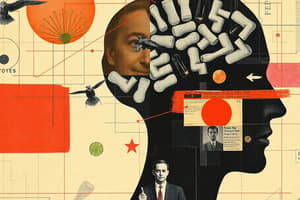Podcast
Questions and Answers
ما هو تعريف الهيئة ؟
ما هو تعريف الهيئة ؟
العناية بالمظهر الشخصي للفرد، مثل الملابس، والنظافة، والمظهر العام.
ما هو تعريف stereotypy في علم النفس؟
ما هو تعريف stereotypy في علم النفس؟
تكرار الكلام والحركة دون جدوى أو هدف.
ما هو تعريف mannerism في علم النفس؟
ما هو تعريف mannerism في علم النفس؟
تكرار الحركة بشكل مبالغ فيه لكن تصبح ذات دلالة أو أهمية بالنسبة للفرد.
ما هو تعريف perseveration في علم النفس؟
ما هو تعريف perseveration في علم النفس؟
ما هو تعريف echolalia في علم النفس؟
ما هو تعريف echolalia في علم النفس؟
ما هو تعريف echopraxia في علم النفس؟
ما هو تعريف echopraxia في علم النفس؟
ما هو تعريف negativism, resistance and rigidity في علم النفس؟
ما هو تعريف negativism, resistance and rigidity في علم النفس؟
ما هو تعريف catatonic excitement في علم النفس؟
ما هو تعريف catatonic excitement في علم النفس؟
ما هو تعريف catatonic posturing في علم النفس؟
ما هو تعريف catatonic posturing في علم النفس؟
ما هو تعريف catatonic stupor في علم النفس؟
ما هو تعريف catatonic stupor في علم النفس؟
ما هو تعريف catatonic rigidity في علم النفس؟
ما هو تعريف catatonic rigidity في علم النفس؟
Flashcards
مظاهر المظهر العام والسلوك
مظاهر المظهر العام والسلوك
تقييم المظهر العام، والسلوك، والنظافة الشخصية، والأوضاع الجسدية الظاهرة.
الكلام (اللغة)
الكلام (اللغة)
تقييم سلاسة وسرعة الكلام، ووضوحه، ومناسبته. مثال: سريع، بطيء، غير منظم.
المزاج
المزاج
الحالة العاطفية المُستدامة للمريض، والتي يُلاحظها المريض و الآخرون.
محتوى الفكر
محتوى الفكر
Signup and view all the flashcards
الإدراك
الإدراك
Signup and view all the flashcards
الاتجاه
الاتجاه
Signup and view all the flashcards
الذاكرة
الذاكرة
Signup and view all the flashcards
الانتباه والتركيز
الانتباه والتركيز
Signup and view all the flashcards
الذكاء
الذكاء
Signup and view all the flashcards
البصيرة / الحكم
البصيرة / الحكم
Signup and view all the flashcards
ترديد الكلام أو الحركة (إيكولاليا / إيكوبراكسيا)
ترديد الكلام أو الحركة (إيكولاليا / إيكوبراكسيا)
Signup and view all the flashcards
التعنت
التعنت
Signup and view all the flashcards
التخيل
التخيل
Signup and view all the flashcards
الخوف (القلق)
الخوف (القلق)
Signup and view all the flashcards
الهياج
الهياج
Signup and view all the flashcards
التجمد (التصلب)
التجمد (التصلب)
Signup and view all the flashcards
الهلوسة
الهلوسة
Signup and view all the flashcards
Study Notes
Mental State Examination Components
- General Appearance and Behavior: Includes talk, mood, thought content, perception, orientation, memory, attention, concentration, intelligence, and insight/judgment.
- Appearance: Focuses on build, posture, dress, grooming, hygiene, and physical abnormalities; noting if the person looks healthy or sick, signs of anxiety (e.g., wet hands, wide eyes), and level of alertness (e.g., somnolent, alert). Also includes attitude toward the examiner (cooperative or uncooperative).
- Behavior: Examines stereotypy (repetitive speech/action without significance), mannerism (repetitive movements with significance), perseveration (repeating the same act despite stopping desire), echolalia (imitating words), echopraxia (imitating actions), negativism (resistance to movement), and catatonic symptoms (excitement, posturing, stupor, rigidity).
- Speech: Evaluates stream (normal speech, hurrying etc.) and analyzes factors such as pressure of speech, circumstantiality (excessive unnecessary details), tangential thought (not getting to the point), and flights of ideas (change of stream).
Mood and Emotional Intensity
- Increased Intensity: Includes increased sadness (depression), irritability, anhedonia (loss of pleasure), increased happiness (euphoria, elation, exaltation, ecstasy), and increased fear and anxiety (related to external or internal danger).
- Decreased Intensity: Characterized by flat affect (absence of emotional expression).
- Abnormal Emotions: Includes incongruity (disharmony between affect and thought content), ambivalence (contradictory emotions), and emotional liability (rapid shifts between emotions).
Disorders of Thought
- Disorders of Content: Delusions (fixed, false beliefs), types include persecution, reference, grandeur, influence, hypochondriacal and nihilistic delusions, self-blame delusions, poverty delusions.
- Obsessions: Recurrent thoughts, images, or impulses that are distressing, along with compulsions (repetitive behaviors).
- Disorders of Possession: Include thought withdrawal, thought insertion, and thought broadcasting.
Perception
- Illusions: False perceptions of the environment.
- Hallucinations: False perceptions without sensory stimulus (e.g., hearing voices). Includes types like auditory hallucinations (voices, sounds), visual hallucinations (seeing things), gustatory hallucinations (tastes), olfactory hallucinations (smells), tactile hallucinations (sensations of insects). Orientation, Memory, and Disorders of Memory are also categorized.
Other Psychotic Disorders and Conditions
- Brief Psychotic Disorder: Characterized by hallucinations, delusions, disorganized speech, and grossly disorganized or catatonic behavior. Symptoms present for more than one day, but less than 30 days.
- Schizophreniform Disorder: Similar to schizophrenia, but symptoms last for more than one month but less than 6 months. Includes characteristics of hallucinations, delusions, disorganized speech, grossly disorganized or catatonic behavior, and negative symptoms.
- Schizoaffective Disorder: Involves a period of symptoms that meet criteria for both schizophrenia and a mood disorder, such as mania or depression.
- Delusional Disorder: Involves non-bizarre delusions (not obviously false) that persist for at least one month; patient's overall function is not impaired.
Personality Disorders
- Cluster A (Odd/Eccentric): Paranoid, schizoid, schizotypal.
- Cluster B (Dramatic/Erratic): Antisocial, borderline, histrionic, narcissistic.
- Cluster C (Anxious/Fearful): Avoidant, dependent, obsessive-compulsive. PDs are characterized by maladaptive patterns of thinking, feeling, and behaving that are pervasive, inflexible, and enduring. They can have a wide range of symptoms and outcomes. Risk factors, prevalence, course, symptoms, and treatment are also included.
Studying That Suits You
Use AI to generate personalized quizzes and flashcards to suit your learning preferences.




